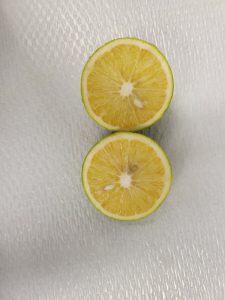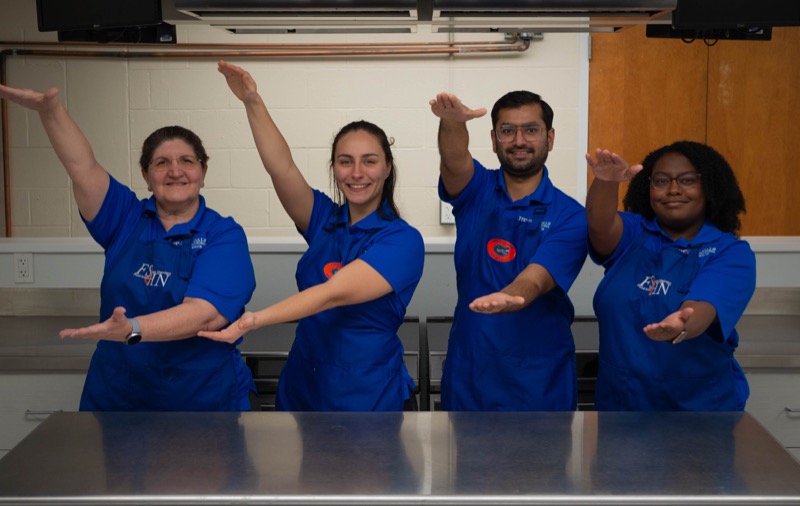 We are pleased to welcome you back to FSHN Research Journeys, which follows the research of graduate students in the Food Science and Human Nutrition program at UF. Today’s guest poster is Taylor Washington, a first-year master’s degree student in food science. She is working under the mentorship of Dr. Liwei Gu. Read on to discover how she uses special laboratory techniques to remove bitterness from orange juice and whole oranges. This research could support a citrus industry in crisis due to a devastating disease.
We are pleased to welcome you back to FSHN Research Journeys, which follows the research of graduate students in the Food Science and Human Nutrition program at UF. Today’s guest poster is Taylor Washington, a first-year master’s degree student in food science. She is working under the mentorship of Dr. Liwei Gu. Read on to discover how she uses special laboratory techniques to remove bitterness from orange juice and whole oranges. This research could support a citrus industry in crisis due to a devastating disease.
Taylor:
Resilience is the ability to adapt in the face of hardship. The Florida citrus industry has endured countless setbacks in its fight against citrus greening, a disease that leaves many of its infected fruits lacking in flavor and taste. Still, researchers, citrus growers, and producers have come together to revive the industry and improve citrus fruits and juices with hopes of protecting the Florida citrus economy.

The Devastating Effects of Huanglongbing
Huanglongbing (HLB), also known as citrus greening, is a disease first seen in Florida in 2005 before quickly spreading throughout Florida citrus groves. With most US citrus production occurring in Florida, HLB is devastating to the citrus industry. The Asian citrus psyllid carries the infectious bacteria, Candidatus Liberibacter, to citrus trees.1 The infection leads to an accumulation of starch which blocks the phloem of citrus trees.2 This can stunt the fruit and tree growth and lead to an accumulation of bitter and sour characteristics. These changes render the infected citrus fruit undesirable.
From 2006 to 2016, the citrus industry reported a loss of approximately $9 billion just in Florida.3 During the 2019-2020 season, citrus growers in Florida experienced a nearly 60% reduction in orange production compared to production prior to 2005.4 The goal of my project is to revamp the Florida citrus juice industry by creating solutions that reduce bitterness and make HLB-infected orange juice more desirable to consumers.

Taylor’s Undergraduate Research Opportunity Inspires Graduate Studies in Food Science
As an undergraduate student, I worked as a research assistant for Dr. Liwei Gu and gained valuable experience in phytochemistry. In his lab, I assisted in a wide variety of projects ranging from the extraction of bioactive compounds to the impacts of those compounds on arthritis, skin health, digestive health, and other health areas.
During my time in Dr. Gu’s lab, I was paired with a graduate student to assist in debittering HLB-infected grapefruit juice. The project aligned well with my interests, but it had an extra challenge because we needed to preserve the juice for consumption. This meant the process had to be approached from food safety, nutrition, and sensory perspectives.
After that experience, I began seeking similar projects for my future graduate research. I was excited to learn that I could continue to work on HLB. This interest and my research project show my commitment to learning and using my experiences to explore post-harvest debittering technologies for the citrus juice industry.
Reviving the Florida Citrus Industry with Post-Harvest Technologies
The Hamlin cultivar is a type of sweet orange that is the most widely produced early season orange in Florida for its orange juice.5 However, with its susceptibility to HLB, its juice can have bitter characteristics that deter consumers.6 My research will contribute to increased sales of Florida citrus juice by developing technologies that will help juice producers to remove or degrade bitter compounds in their orange juice. These technologies will directly benefit Floridians who grow, pack, and process Florida citrus fruits for juice.
By providing a potential solution to the citrus greening crisis, we could deliver hope that Florida oranges can be used and sold even without a cure for the disease. This research could revive the Florida citrus industry and bring stability to many Florida families.

Taylor Focuses on Post-Harvest Debittering Using Absorbent Resins and Citrus Fruit Treatments
My research project includes developing post-harvest debittering technologies for (HLB)-infected oranges and orange juice. For the juice, I will use adsorbent resin beads that selectively hold onto bitter compounds to separate them from the juice. Prior research in my laboratory showed that it is possible to remove the bitter compounds using resins.7 This process must be optimized for each type of fruit juice. In addition, the resin sometimes binds to other bioactive compounds, removing them along with the bitter compounds.

I will track the acid levels as well as the sugar, bioactive compounds, and soluble solids contents of the juice before and after debittering. Trials will use different types of resins and varying conditions such as temperature, speed, and time. We hope to find the most efficient debittering technique that preserves the most sensory characteristics and bioactive compounds.
For whole Hamlin oranges, I will use hot water, air, ethylene, and ethephon gases to degrade the bitter compounds. The resulting juice from the treated fruits will undergo testing like the analysis of debittered juice. Consumer taste panels will evaluate the juice samples for overall consumer acceptability, sourness, bitterness, and metallic flavors. The goal of my research is to contribute findings that bring hope and resilience to Florida citrus producers by providing an innovative way to continue using their orange crops despite the HLB infection.
Taylor Washington is a first-year food science master’s student from Tampa, Florida. As a CALS Top 10 Senior and FSHN Outstanding Senior, she graduated from the University of Florida magna cum laude in Spring of 2021 with a Bachelor of Science in Food Science. As a University of Florida alumni, she is excited to make a lasting impact on the agricultural and food industry while becoming a double gator in the process.
References
- Hijaz FM, Manthey JA, Folimonova SY, Davis CL, Jones SE, Reyes-De-Corcuera JI. An HPLC-MS characterization of the changes in sweet orange leaf metabolite profile following infection by the bacterial pathogen Candidatus Liberibacter asiaticus. PLoS One. 2013;8(11):e79485.
- Bové JM. HUANGLONGBING: A DESTRUCTIVE, NEWLY-EMERGING, CENTURY-OLD DISEASE OF CITRUS. Journal of Plant Pathology. 2006;88(1):7-37.
- Fuchs M, Almeyda CV, Al Rwahnih M, et al. Economic Studies Reinforce Efforts to Safeguard Specialty Crops in the United States. Plant Disease. 2021;105(1):14-26.
- USDA. Florida Citrus Statistic 2019-20. In:2021:14.
- Lee HS, Castle WS, Coates GA. High-performance liquid chromatography for the characterization of carotenoids in the new sweet orange (Earlygold) grown in Florida, USA. Journal of Chromatography A. 2001;913(1):371-377.
- Dagulo L, Danyluk MD, Spann TM, et al. Chemical Characterization of Orange Juice from Trees Infected with Citrus Greening (Huanglongbing). Journal of Food Science. 2010;75(2):C199-C207.
- Gordon RM, Washington TL, Sims CA, et al. Performance of macroporous resins for debittering HLB-affected grapefruit juice and its impacts on furanocoumarin and consumer sensory acceptability. Food chemistry. 2021;352:129367-129367.
 1
1
